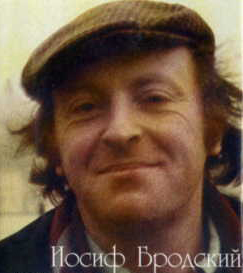11.25.2005 15:59
 A poignant sculpture commemorating the Nobel Prize-winning poet Joseph Brodsky is unveiled.
A poignant sculpture commemorating the Nobel Prize-winning poet Joseph Brodsky is unveiled.
The late poet Joseph Brodsky, one of the giants of St. Petersburg’s cultural heritage, has made a symbolic homecoming to the city where he was born and where he lived for 32 years until he emigrated to the U.S. in 1972. And the poet has come home with his suitcase.
Konstantin Simun’s monument to the emigre poet, called “Brodsky Has Arrived,” which has been installed in the courtyard of the St. Petersburg State University, is the first attempt in St. Petersburg’s to commemorate with a statue the winner of the Nobel Prize for Literature in 1987.
The sculpture depicting Brodsky’s head on top of a bronze suitcase, with his name tag attached to it, is placed simply on the ground and is a reference to the poet’s wandering nature.
The driving force behind the monument is the Diaghilev Arts Center and the University’s Philological Faculty, which is enthusiastically turning its courtyard into a sort of fun sculpture park. The park’s concept, if it exists, is certainly eclectic: its last acquisition before Brodsky was a hippopotamus called Motya.
The monument’s location, however, isn’t designed for mass pilgrimage: access to the University courtyard is afforded only to its staff and students.
Brodsky didn’t study at the Philological Faculty. He had no degree at all. A self-taught translator and poet, Brodsky slammed the door on his school at the age of 15 and never looked back. He worked as a geologist-prospector, a morgue attendant and a stockman, and after being forced into exile in the U.S. in 1972, he became a university professor without a diploma.
In his years in the Soviet Union, Brodsky’s poetry was published secretly — attracting as much attention from literary circles as from the KGB.
Placed in a psychiatric hospital for political reasons in 1965, he was subsequently confined to a collective farm in the Archangelsk Oblast on charges of social parasitism — a Soviet term for not having a permanent job. Brodsky spent his years after being thrown out of the U.S.S.R writing and lecturing in the West.
Simun’s most famous sculpture so far is the monument to the Siege of Leningrad called “The Broken Ring of Blockade.”
“I am both happy and amazed that the Brodsky monument has been installed,” Simun said at an opening ceremony last week.
Tatyana Yuriyeva, director of the Diaghilev Arts Center, knew Joseph Brodsky personally.
“In his last years, it was an open question as to whether Brodsky would come back to St. Petersburg,” Yuriyeva said at the ceremony. “The monument looks independent, detached and somewhat desolate in the courtyard, resembling the way the poet lived.”
Brodsky died in 1996.
The new monument is not connected to the notorious competition for the best Brodsky monument which was launched in 2002 with support from Alfa-Bank. Although that monument had been scheduled to be in place in time for the 300th anniversary of St. Petersburg in 2003, the winning design by sculptor Vladimir Tsivin hasn’t seen the light of day.
The of fate Tsivin’s design — two pillars inscribed with Brodsky’s verse next to steps leading to the River Neva — was sealed by its suggested location on the Neva embankment near the State Mining Institute.
The city’s committee for the preservation of architectural monuments banned the work on the grounds that the embankment, being a historical monument, cannot be altered.
Simun took part in the competition and even became one of its finalists but his project wasn’t selected.
Any location in the city other than Vasilievsky Island, where the University is located and where the scuppered 2003 design would have stood, would be unsuitable as most people associate Brodsky with this part of St. Petersburg.
One of the most famous lines from Brodsky’s verse is “I will come to die on Vasilievsky Island.”
The consensus that Vasilievsky Island is the only suitable site for an official monument on the strength of this line has been criticised for not saying anything new about Brodsky.
Although he could have done, Brodsky never returned to Russia after the fall of the Soviet Union and he died in New York. According to his wishes he was buried in Venice, Italy.
But those who knew the poet personally explain that Vasilievsky Island is suitable in a much wider sense.
“Brodsky frequented [one of] our friend’s apartment on Vasilievsky Island [when the friend was St. Petersburg State University student], and this ‘house with the dark-blue faÍade’ is present in his verse,” said Yakov Gordin, editor of the literary magazine Znamya and a member of the Expert Council of the Brodsky Monument Competition. “For Brodsky, Vasilievsky Island appeared to be the essence of St. Petersburg as a symbol of the city.”
When Brodsky died, St. Petersburg’s late mayor Anatoly Sobchak promised to do “everything in our power to ensure that the memory of Brodsky is preserved forever in his native city.”
Sobchak’s successor Vladimir Yakovlev gave written approval for the creation of a Brodsky Memorial Apartment Museum, and Yakovlev’s successor, Governor Valentina Matviyenko, urged action at a government meeting in May of this year. But Tsivin’s monument is still hanging in the air.
But, poignantly, a desolate suitcase placed in a closed courtyard is for now Brodsky’s only public memorial in St. Petersburg.
News source: times.spb.ru
 Print this news Print this news
Culture news archive for 25 November' 2005.
Culture news archive for November' 2005.
Culture news archive for 2005 year.
|